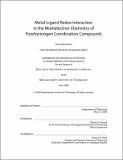| dc.contributor.advisor | Daniel G. Nocera. | en_US |
| dc.contributor.author | Bachmann, Julien | en_US |
| dc.contributor.other | Massachusetts Institute of Technology. Dept. of Chemistry. | en_US |
| dc.date.accessioned | 2007-01-10T15:39:23Z | |
| dc.date.available | 2007-01-10T15:39:23Z | |
| dc.date.copyright | 2006 | en_US |
| dc.date.issued | 2006 | en_US |
| dc.identifier.uri | http://hdl.handle.net/1721.1/35314 | |
| dc.description | Thesis (Ph. D.)--Massachusetts Institute of Technology, Dept. of Chemistry, 2006. | en_US |
| dc.description | This electronic version was submitted by the student author. The certified thesis is available in the Institute Archives and Special Collections. | en_US |
| dc.description | Vita. Page 257 blank. | en_US |
| dc.description | Includes bibliographical references. | en_US |
| dc.description.abstract | Metal complexes of the macrocycle porphyrinogen (calix[4]pyrrole) are studied with an emphasis on the redox activity ("non-innocence") of the ligand (Chapter I). Porphyrinogen complexes of spherical, redox-inert metal dications exist in three oxidation states, dianionic, neutral, and dicationic, characterized structurally by zero, one, and two direct bonds between adjacent pyrroles, respectively. All three are isolated on the preparative scale, and interconverted electrochemically (Chapter II). Each carbon-carbon bond functions as a reservoir of two redox equivalents. The neutral oxidation state exhibits an optical intervalence charge transfer transition, characteristic of ligand-based two-electron mixed valency (Chapter III). Dianionic zinc porphyrinogen reacts with carbon dioxide, and neutral zirconium(IV) porphyrinogen with dioxygen. Two zirconium porphyrinogen units can carry a water molecule as an oxo bridging the metals and two protons on the ligands (Chapter IV). Iron porphyrinogen has three available oxidation states, a dianion, a monoanion, and a dication. The interconversion of the latter two is a selective three-electron transformation, preparatively and electrochemically (Chapter V). complex are largely decoupled from each other and can be chosen independently (Chapter IX). | en_US |
| dc.description.abstract | (cont.) Crystallographic analysis shows that both anionic oxidation states contain the reduced ligand, whereas the dicationic state is based on the oxidized ligand (with two C - C bonds). Paramagnetic NMR confirms the structures in solution. Spectroscopies (EPR, Mössbauer) allow the assignment of well-defined individual oxidation and spin states states for the metal within each overall oxidation state of the complex (Chapter VI). The iron porphyrinogen dication is an oxidant based on an iron(II) center; it oxidizes iodide to diiodine (Chapter VII). The cobalt(II) porphyrinogen dianion can take up two protons, then photoreact to yield reduction of at least one proton to a metalbound hydride, as evidenced by infrared spectroscopy (Chapter VIII). Overall, the results afford a picture of metal-porphyrinogens including structure, electronic structure, and reactivity. The ligand supplements the central metal ion by functioning as a multielectron reservoir. Therefore, the (metal-based) coordination and (ligand-based) redox properties of a given porphyrinogen | en_US |
| dc.description.statementofresponsibility | by Julien Bachmann. | en_US |
| dc.format.extent | 257 p. | en_US |
| dc.format.extent | 12857068 bytes | |
| dc.format.extent | 12856763 bytes | |
| dc.format.mimetype | application/pdf | |
| dc.format.mimetype | application/pdf | |
| dc.language.iso | eng | en_US |
| dc.publisher | Massachusetts Institute of Technology | en_US |
| dc.rights | M.I.T. theses are protected by copyright. They may be viewed from this source for any purpose, but reproduction or distribution in any format is prohibited without written permission. See provided URL for inquiries about permission. | en_US |
| dc.rights.uri | http://dspace.mit.edu/handle/1721.1/7582 | |
| dc.subject | Chemistry. | en_US |
| dc.title | Metal-ligand redox interaction in the multielectron chemistry of porphyrinogen coordination compounds | en_US |
| dc.type | Thesis | en_US |
| dc.description.degree | Ph.D. | en_US |
| dc.contributor.department | Massachusetts Institute of Technology. Department of Chemistry | |
| dc.identifier.oclc | 77277814 | en_US |
